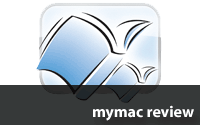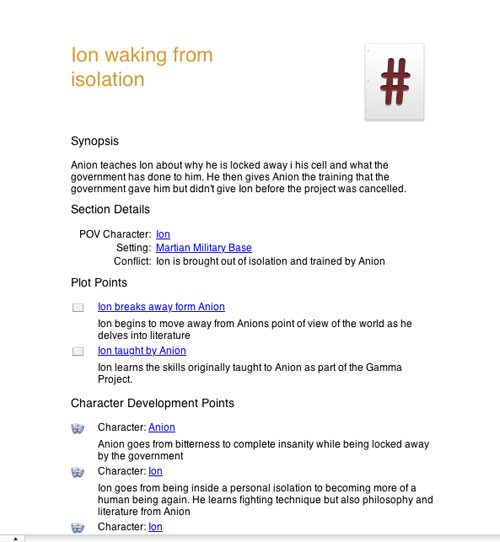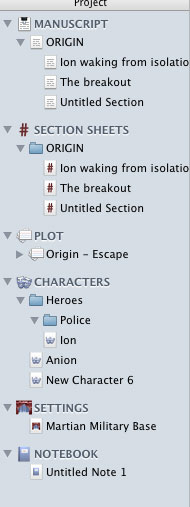
Storyist
Company: Storyist Software
Price: (Download + CD) — $69.00
(Download Only) — $59.00
http://www.storyist.com/
With Apple’s continued success with artists it’s no surprise that an abundance of writing tools are written for the platform. Storyist is a unique tool that really takes advantage of OSX and is geared towards creative writers. Storylist is an organization tool, word processor, and format template for novelists and screen writers. But the question that I ask myself when confronted with one of these organization aids is, will this be better than a standard spreadsheet?
The real power of Storyist comes from the organization ability it gives writers. It breaks your manuscript down into chapters and then your chapters down into scenes, allowing the writer to assign specific characters and settings to specific plot points.
Advertisement —>
In microsoft training, an mcp is trained up to the level of mcdst, putting any other security training behind you.
<—-Advertisement
Breaking down the organizational categories we get; Setting, Characters, and Plot. A writer can sit down with the software and write out each character he or she wants to include in the story, each setting where the story will take place, and then an outline of events. Once you have items in these lists you can assign them to a section. A section, again, is a scene in a chapter. You create a link to the plot point, the character, and the setting in the section sheet creating a reference sheet to help you while writing the story.

An example of a Storyist Section Sheet
You group section sheets by chapter. Once this is done the section dividers appear on the manuscript, ready for you to fill in prose. An outline of your chapter allows you to easily reorganize the sequence of sections in a chapter, or offers a visual outline where your section sheets show up as index cards tacked to a cork-board. For characters or settings the index cards are replaced with a piece of artwork. This gives you the ability to use a picture of a hotel for a setting sheet that describes a hotel in your novel. These visual aids can help you quickly find what information you need.
Each category allows two levels of organization to allow grouping similar notes together. For example, you can create a list of characters and fill out their character sheets, then separate them into groups such as “Heroes” and “Villains.” For even further organization you can also create subgroups by dragging one group into another. This gives the author the power to organize setting and characters into as many subgroups as he wishes. Under the Heroes category you can make a “Police†folder and only include those character that are also members of the police. This might seem an obviously point, but when you have a list of dozens or hundreds of characters the ability to group them as specifically as possible is important. Unfortunately you can’t do this under Manuscript, the only organization you can do is by chapter and section.

An example of how Storyist organizes your notes
One cool aspect of these “story sheets” are the fields you can add. The Character Sheet, for example, starts off prompting you for “Age, Gender, Eye Color, Hair Color, and Build” but you can swap out or add other preset fields or make up your own, offering a customizable experience.
Storyist allows you to easily export your manuscript in RTF format. It’s a little hard to export characters or scenes, but it’s possible to create a template and leave the information you want to move into new projects inside it. This is good for someone who wants to write a sequel but doesn’t want to rewrite all the characters and setting files. Or if the organization of sections and chapters becomes too unruly, which in large novels it might, and the author wants to cut his novel into two different Storyist files.
Usability of Storyist is as expected from any native OSX program. If you have a section selected, clicking the “+†will create a new section sheet, similar to adding a new play list in iTunes. The User Interface is intuitive and the learning curve is almost nothing. Everything is presented clearly and it’s obvious how the features work. But if you have problems an easy step-by-step help file is included. I assumed I was missing some features but after checking the help file I realized that I had learned the software by just playing around for a few minutes. That’s the sign of good design decisions.
Storyist is a powerful program, but for some writers it might be too powerful. As an organic writer I’m kind of overwhelmed that it asks me to chop up my chapters into sections and document everything I’m going to be putting into the story. But for some writers that might be what they are looking for, and every writer works differently. Storyist is a fun program to play with, but you need to try it out before deciding if it’s going to be useful for you. Some authors might not want to leave the standard word processor, or might not want to relay completely on proprietary software to store all their notes.
Even if you aren’t going to use all of the features of Storyist I find the fact that my manuscripts will be perfectly formated and ready for submission, and the character organization features alone to be enough to convince me to use Storyist. But the price is Storyists greatest weakness. At $60 for the download version it’ll be hard to justify unless you are absolutely desperate for precise organization.
I can’t blankly recommend Storyist to every writer but I recommend downloading the 15 day free trial and playing with it. With the fully functional 15-day trial, users who are new to the program should have plenty of time to decide if the software will be useful or not. Even if you don’t think the whole suite will be useful I guarantee that you’ll find at least one feature that’ll be hard to live without.
Overall Storyist is a solid piece of software. Users who take advantage of it will find they cannot live without it after a short period of time. Some small flaws are the limited way you can export your notes, characters, plots, and settings. Plus the fact that Storyist files are not an open standard making it impossible to move to a different organization program in the future.
email – MyMac Magazine – Twitter – Advertise – Reviews Archive – Podcast

Leave a Reply
You must be logged in to post a comment.